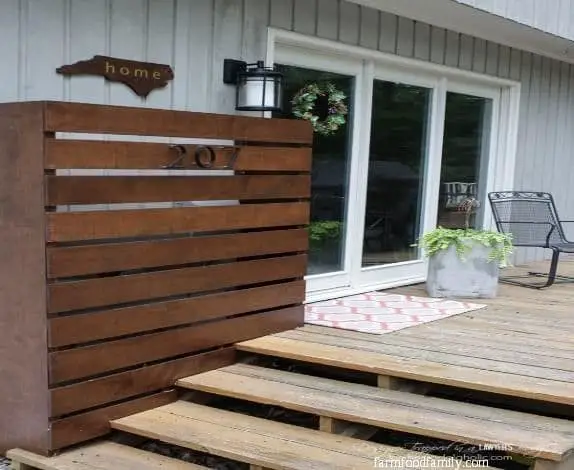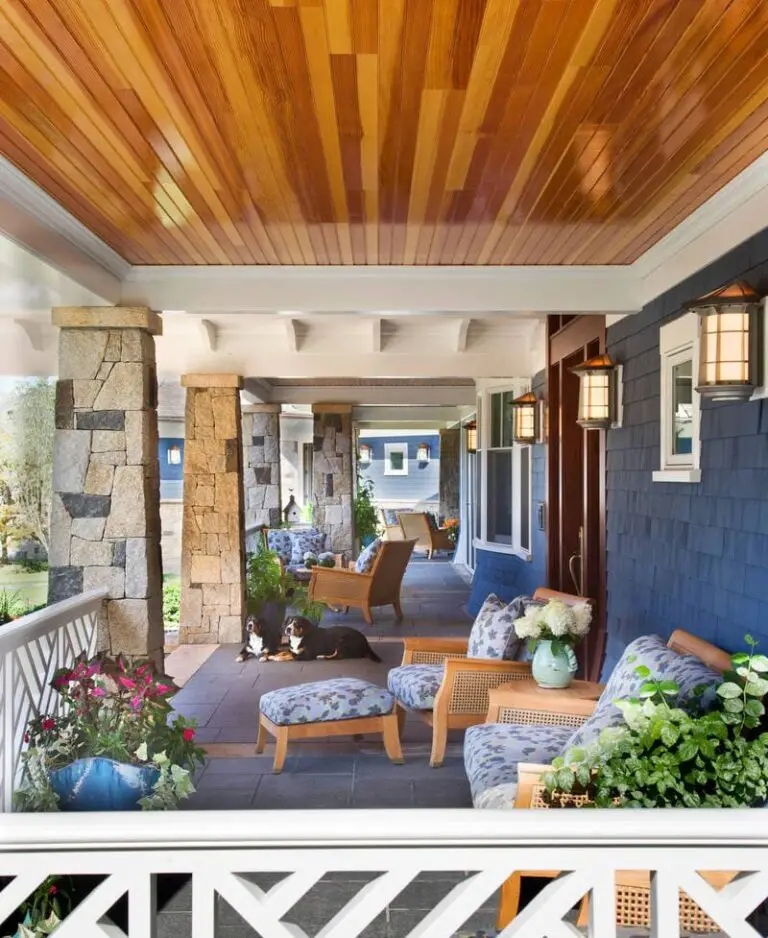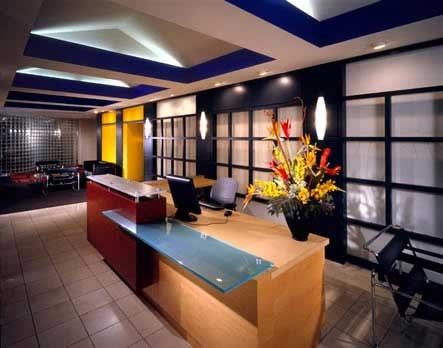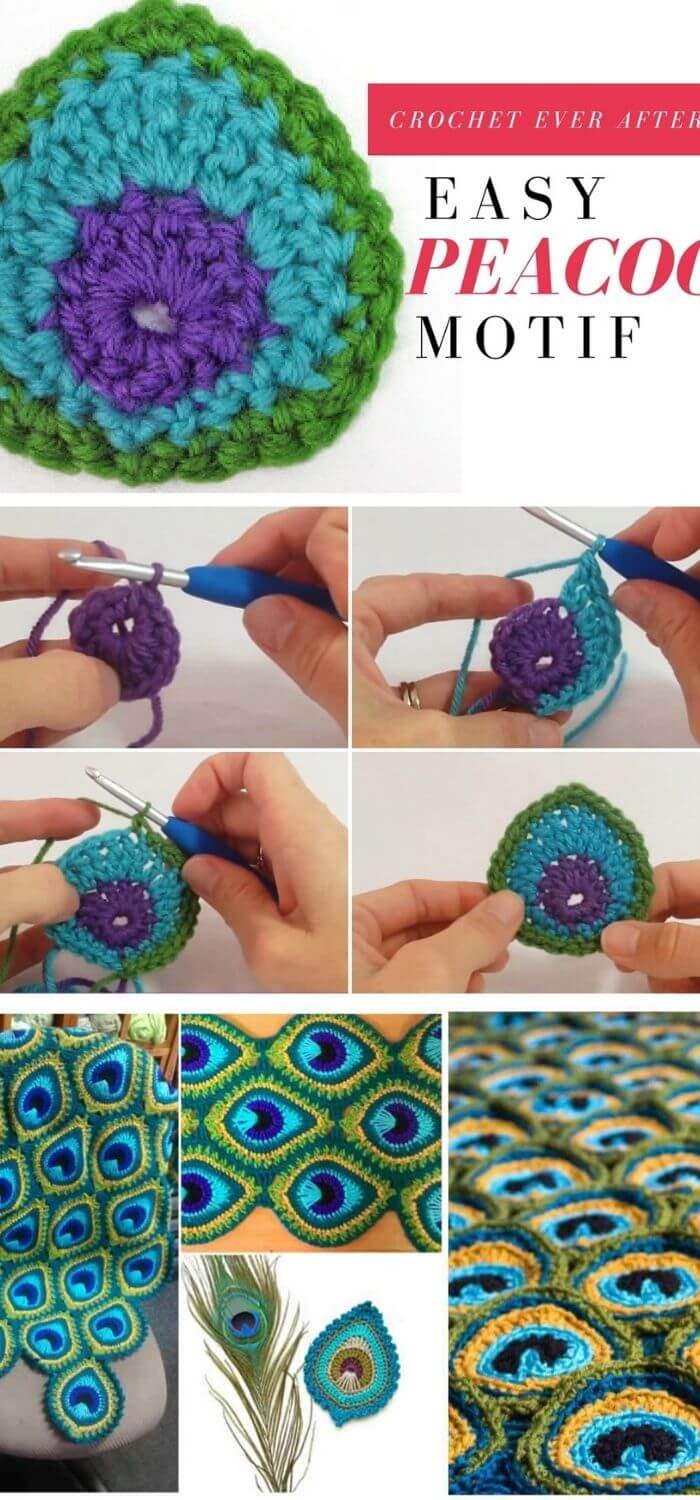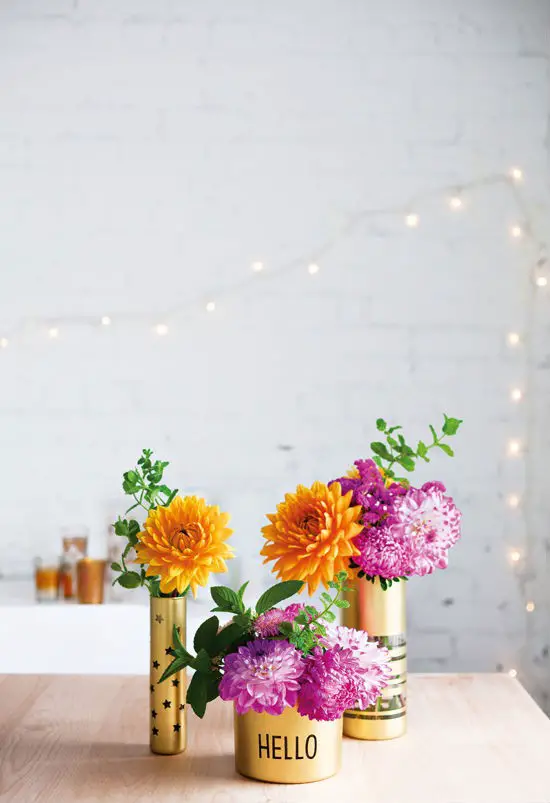What Can You Put On Bathroom Walls Instead Of Tiles: Alternative Coverings Explored
In recent years, traditional bathroom design has evolved beyond the classic tile approach. Modern homeowners now have the freedom to get creative with their bathrooms, opting for a variety of materials that not only withstand moisture but also add unique textures, colors, and styles to the space. From paint solutions to wood treatments and wall panels, there are numerous alternatives to tiles that can transform a bathroom’s ambiance.
Paint options provide a vast spectrum of color choices and finishes, allowing for simple yet impactful updates. Wood treatments, when properly sealed and maintained, offer a warm and organic feel. Wall panels have also gained popularity, offering PVC, laminate, and other designs that mimic the look of more expensive materials at a fraction of the cost. With so many options available, homeowners can now personalize their bathrooms to suit their unique tastes and preferences.
Key Takeaways
Beyond the conventional tile options, homeowners seeking to personalize their bathroom spaces can explore a diverse array of alternative materials for walls. From classic paint and wood finishes to cutting-edge wall panels, each choice presents distinct aesthetic possibilities.
However, when selecting non-traditional options, it’s crucial to consider factors such as moisture resistance, maintenance requirements, and overall cost – ultimately ensuring that the chosen material aligns with the desired style and functionality.
Paint Solutions
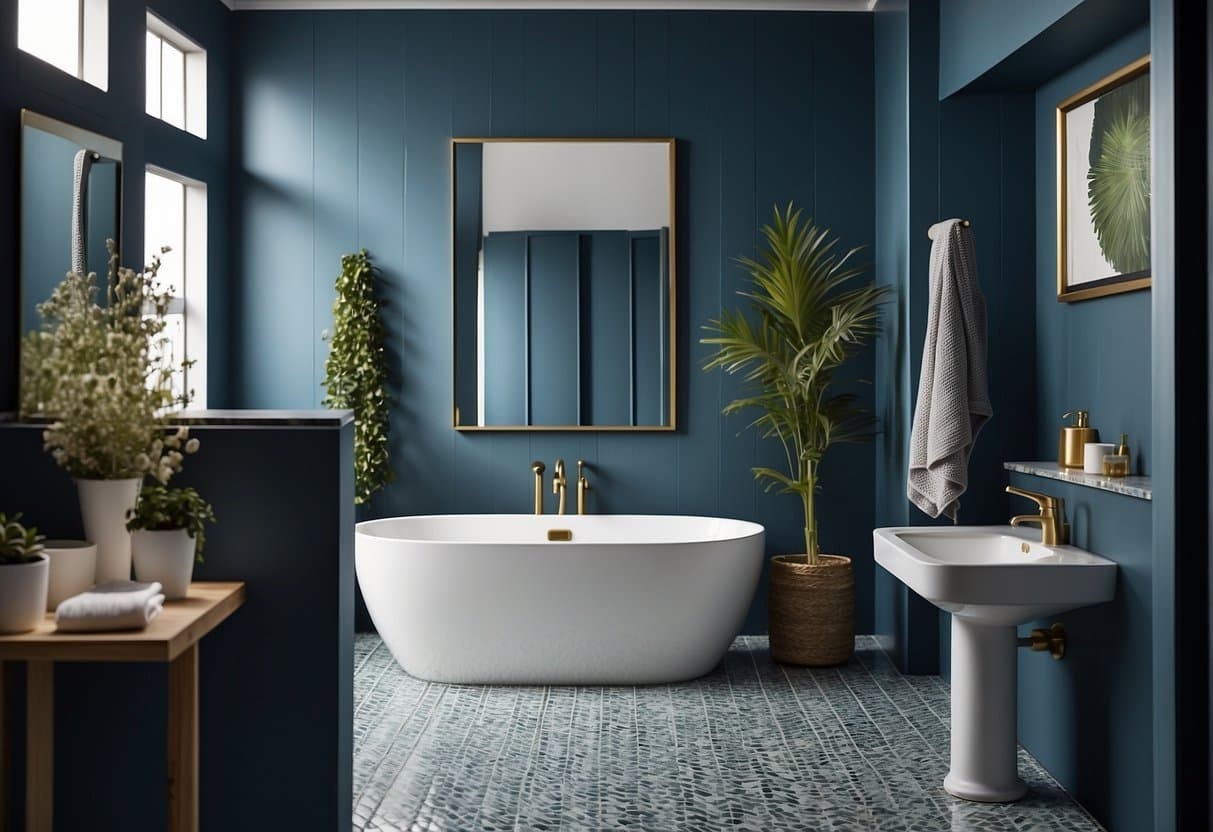
In the quest for a bathroom makeover, painting the walls offers a refreshing alternative to traditional tiles. This approach is not only budget-friendly but also provides an array of creative possibilities. Crucially, it’s essential to choose a paint that can brave the humid conditions of a bathroom and resist mold growth, ensuring a fresh and clean appearance that lasts.
Choosing the Right Paint
When it comes to painting bathroom walls, choosing the right type of paint is essential. To withstand the humid conditions, you’ll want to opt for a high-quality, semi-gloss or high-gloss paint that’s designed to handle frequent exposure to moisture and steam. These paints feature a shinier finish than matte options, which not only makes them easier to clean but also more resistant to the growth of mold and mildew, making them an ideal choice for bathroom spaces.
Waterproof Bathroom Paint
When it comes to painting areas of your bathroom that come into direct contact with water, such as those near the shower or bathtub, it’s crucial to opt for a specialized waterproof paint. This type of paint forms a moisture barrier on the wall surface, effectively preventing water from penetrating and causing damage.
Some high-quality products are specifically designed to provide a durable, long-lasting coat that resists humidity and withstands exposure to water, making them an excellent choice for bathroom walls.
Color Options
In the realm of bathroom design, color selection plays a vital role in creating an illusion of space. While the options may seem limitless, it’s worth noting that lighter hues can work wonders in making a small bathroom feel more expansive and airy. On the other hand, bolder or darker colors can be used to make a statement. A crucial aspect to consider is how the chosen color will impact the perception of light and space within the room.
To ensure the paint maintains its vibrant appearance over time, it’s recommended to incorporate mildew-resistant additives or opt for paints that already possess these properties.
Wood Treatments
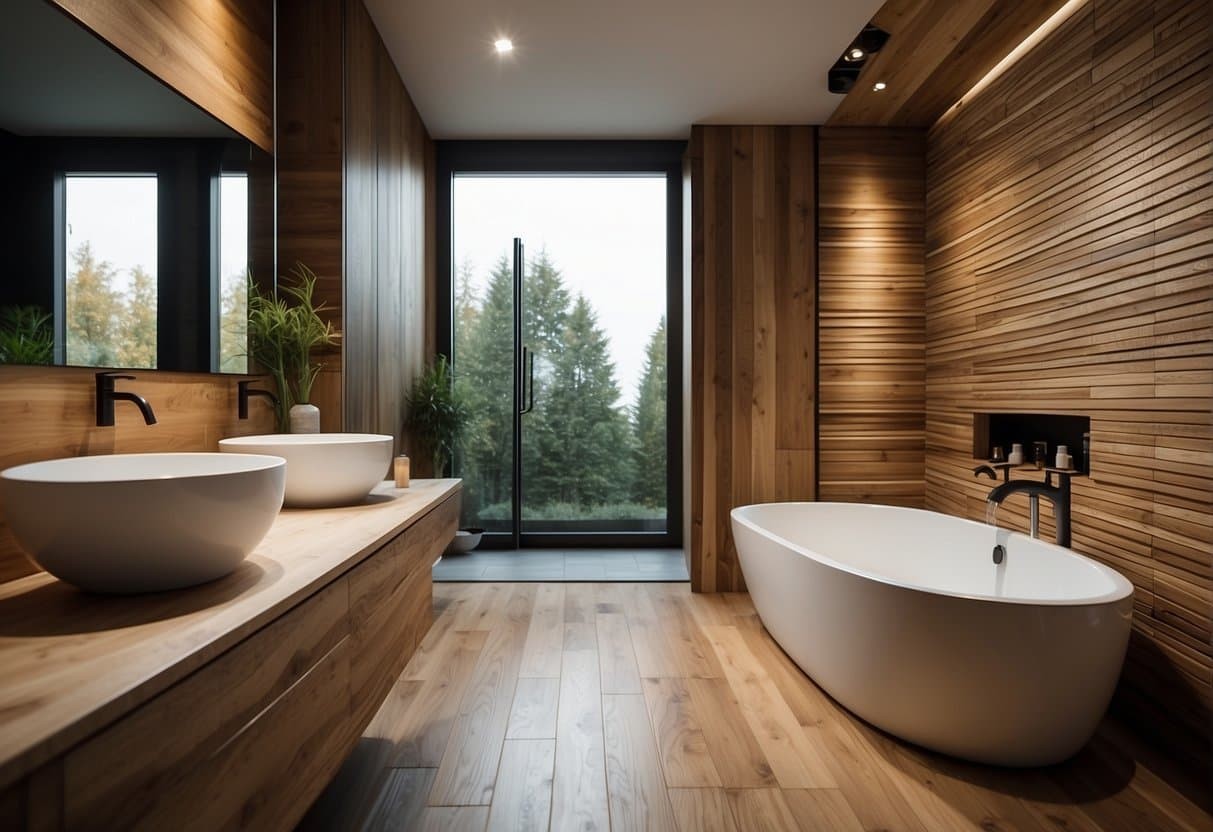
Wooden treatments for bathrooms provide a distinctive and captivating visual appeal that can effortlessly introduce a cozy ambiance and a rustic charm to any bathroom design. By embracing their organic essence, these alternatives to traditional tiles can elevate the space with a sense of warmth and character, making it an inviting area to relax and rejuvenate.
Water-Resistant Wood Panels
In bathrooms, where humidity is a constant concern, water-resistant wood panels play a crucial role in maintaining a comfortable and durable space. The manufacturing process typically involves treating these panels to repel moisture effectively, thereby preventing the warping and decay that untreated wood might experience.
A significant benefit of water-resistant wood panels is their ease of installation, which can be less labor-intensive compared to traditional tiling methods, making them an attractive option for homeowners seeking a low-maintenance solution.
Natural Wood Aesthetics
The incorporation of natural wood brings a unique warmth and rustic charm, effortlessly pairing with a wide range of interior design styles, from modern sleekness to cozy country flair. The inherent grains and textures of this organic material provide an authentic look that can be difficult for tiles or other surfaces to replicate. To preserve the natural beauty of these wood treatments, proper sealing is crucial, and regular maintenance may also be necessary.
When done correctly, the aesthetic appeal of natural wood can create a calming and serene atmosphere, making it an attractive choice for those seeking to transform their bathroom into a peaceful retreat.
Wall Panel Innovations
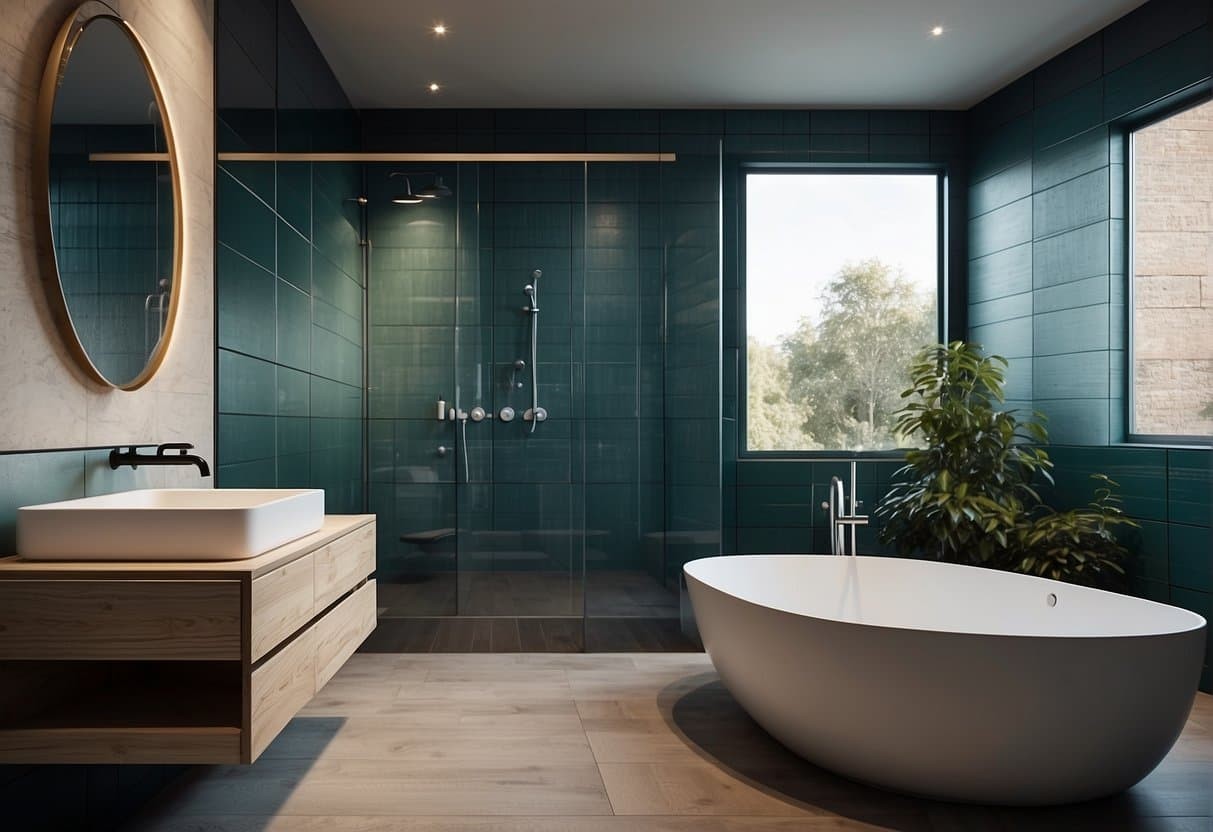
The humble wall panel has undergone a significant transformation in the realm of bathroom design. Gone are the days of laborious tiling processes, replaced by innovative solutions that prioritize durability, affordability, and style. The introduction of water-resistant materials such as PVC, acrylic, and laminate has opened up new possibilities for homeowners seeking to upgrade their bathrooms without breaking the bank.
With these modern alternatives, traditional tiling methods now seem quaint, relics of a bygone era.
PVC Wall Panels
PVC wall panels have garnered popularity in modern bathroom renovations due to their inherent water-resistance and budget-friendly pricing. Weighing in at a lightweight, these panels are also remarkably easy to install, making them an attractive option for homeowners seeking a quick renovation fix. What’s more, their versatility allows them to be mounted over existing tiles, streamlining the entire process and minimising disruption.
Acrylic Wall Panels
Acrylic wall panels have gained popularity due to their sleek finish, vast array of colors and patterns, and ability to mimic high-end designs. One of the most significant advantages is their waterproof nature, making them an ideal choice for bathroom walls where a stylish yet practical solution is desired. Moreover, they provide a seamless appearance that can be easier to maintain compared to traditional tiles, adding to their overall appeal.
Laminate Wall Panels
With laminate panels, you can achieve a stunning visual effect, selecting from an array of designs that span elegant wood finishes to modern patterns. Moreover, these durable options are exceptionally resilient in the face of moisture, making them a practical choice for shower enclosures and full bathroom installations. What’s more, laminate panels seamlessly merge aesthetic appeal with functional durability, delivering a long-lasting solution that beautifully balances style and utility.
Natural Stone and Alternatives
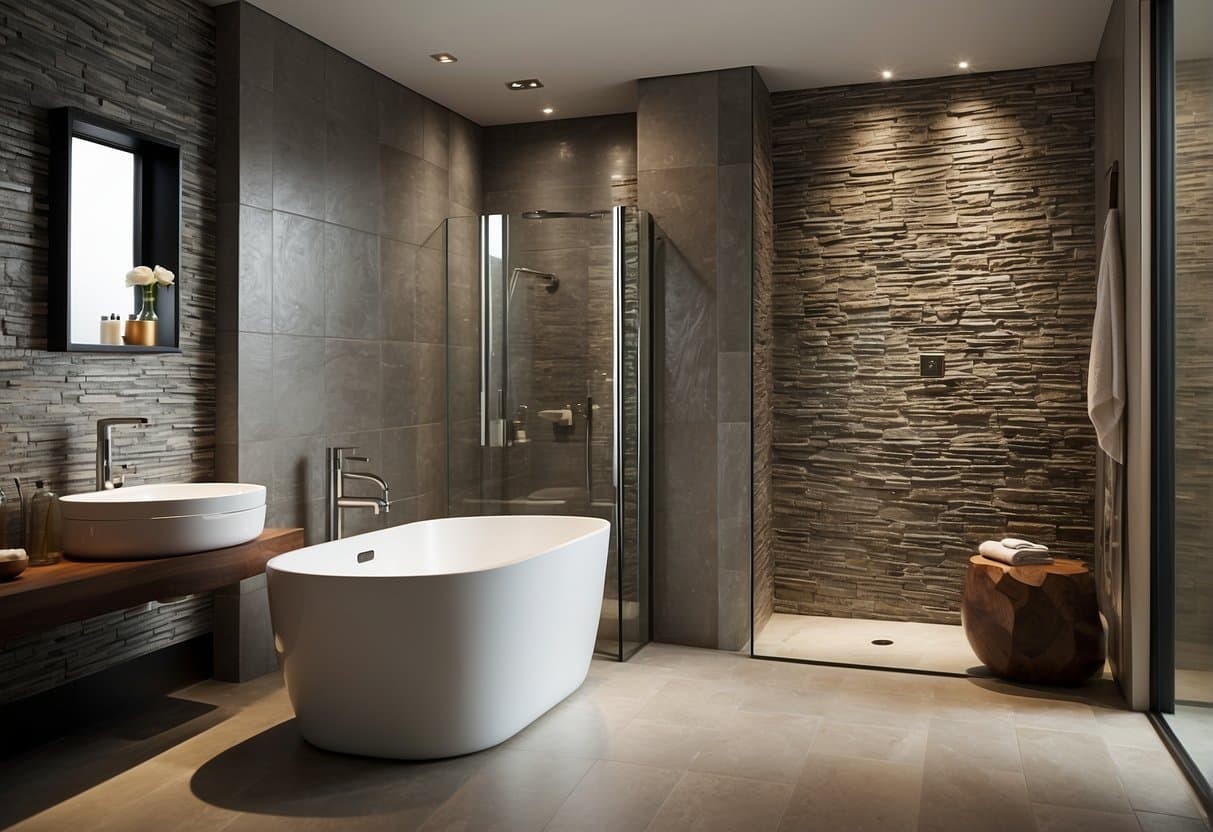
Selecting unconventional options over traditional bathroom wall tiling opens up a world of textures and designs, accompanied by the added advantages of durability. Options like natural stone and its variants offer high-end finishes that blend seamlessly with either contemporary or timeless bathroom styles.
Stone Slabs and Cladding
Incorporating stone slabs into your bathroom design can instantly evoke a sense of opulence and grandeur. The unbroken surfaces of these stones create a seamless look that seamlessly integrates with its surroundings, making it an excellent choice for homeowners seeking to elevate their bathroom’s aesthetic appeal.
Stone cladding, in particular, offers a unique twist on traditional masonry, allowing you to harness the natural beauty of materials like marble, slate, and granite in a more accessible format. By choosing from a range of stone types, each with its distinct pattern and texture, you can create a visually stunning focal point that adds depth and character to your bathroom walls.
Manufactured Stone Resin
Manufactured stone resin panels have revolutionized the bathroom materials landscape, offering a unique blend of aesthetics and practicality. Rather than relying on traditional natural stone options, these innovative panels provide a lighter, more cost-effective alternative that still boasts the visual appeal of its organic counterpart.
Comprising crushed stone mixed with advanced resins, manufactured stone resin panels are available in an array of colors and patterns that expertly mimic the intricate details found in real stone. This synergy of form and function has made them a sought-after solution for homeowners seeking to elevate their bathroom’s design without breaking the bank.
Advanced Ceramic Options
For those looking for an alternative to stone, advanced ceramic tiles offer a remarkable solution. These ceramics can convincingly mimic stone surfaces, complete with textured finishes that further enhance the illusion. Not only are they aesthetically versatile, but they also boast impressive benefits like moisture resistance and easy maintenance, making them a practical choice for bathroom environments where durability is key.
Cement and Concrete Options
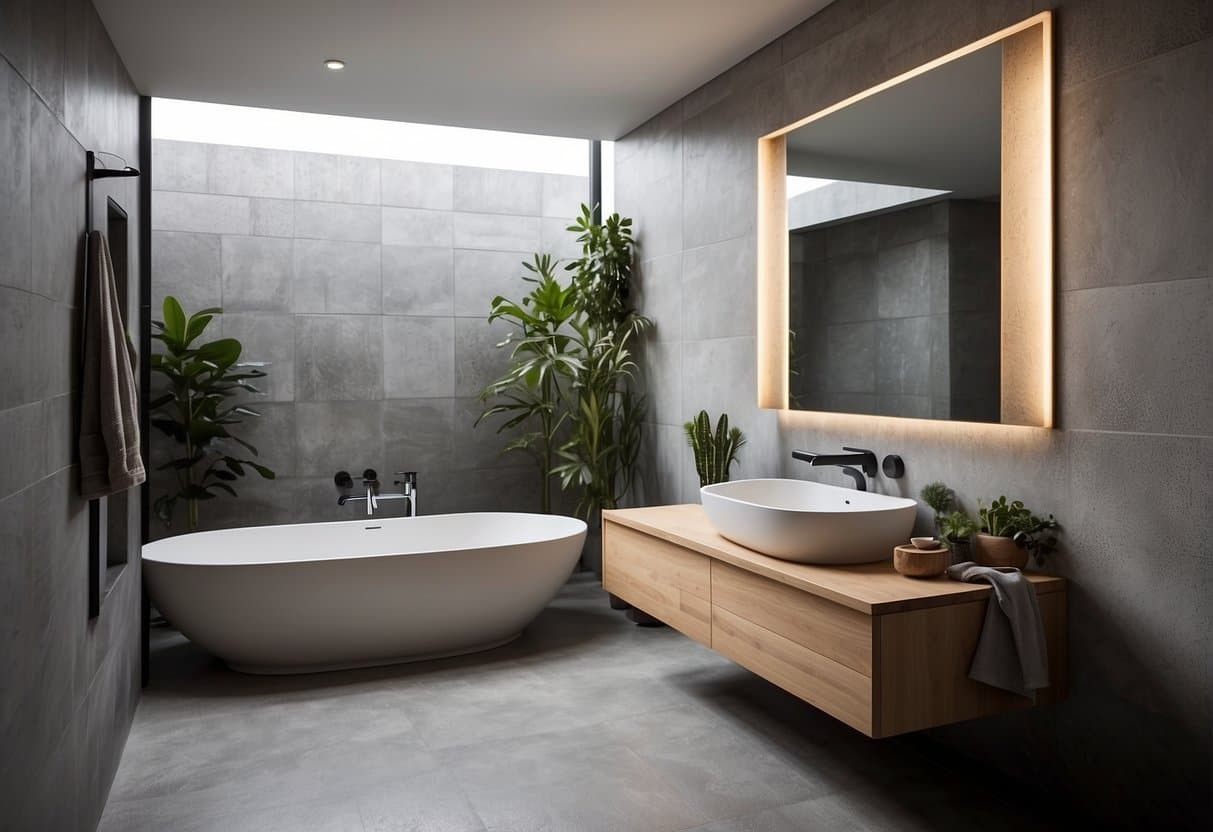
Incorporating cement and concrete finishes into your bathroom design offers a cutting-edge solution that outshines traditional tile options. By embracing this modern alternative, homeowners can expect a visually striking space with a seamless, sleek aesthetic. Moreover, these materials boast impressive durability and require minimal upkeep, making them an attractive choice for those seeking a low-maintenance yet stylish sanctuary.
Microcement Coatings
Microcement is a remarkable coating that can be applied to various surfaces, including bathroom walls. Its polymer-modified cement-based composition allows for a smooth, concrete-inspired finish without the need for heavy application. The versatility of microcement stems from its strength and water-resistance, making it an excellent choice for wet environments like bathrooms. To achieve a polished finish, one can apply layers of microcement and then seal it.
For a detailed guide on application, refer to DIY concrete bathroom walls with Microcement. Some key benefits of microcement include its durability, which makes it suitable for high-traffic areas. It also offers a contemporary, bespoke aesthetic with diverse color options. Moreover, microcement is easy to clean and resistant to bacteria and mold growth, making maintenance a breeze.
Polished Concrete Walls
Polished concrete walls bring an industrial chic to bathrooms, achieved by grinding down existing slabs to a smooth finish and then polishing them to a desired sheen. This unique finish combines the robustness and longevity of concrete with a visually striking appearance. While polished concrete is not as labor-efficient as microcement, it offers an unparalleled level of customization through dyes and designs.
The inherent strength of concrete ensures long-lasting walls that can withstand the test of time, while its polished surface provides a refined ambiance. Additionally, both polished concrete and microcement offer seamless finishes that prevent water penetration and simplify cleaning due to fewer areas for dirt and grime to accumulate.
Metallic Choices
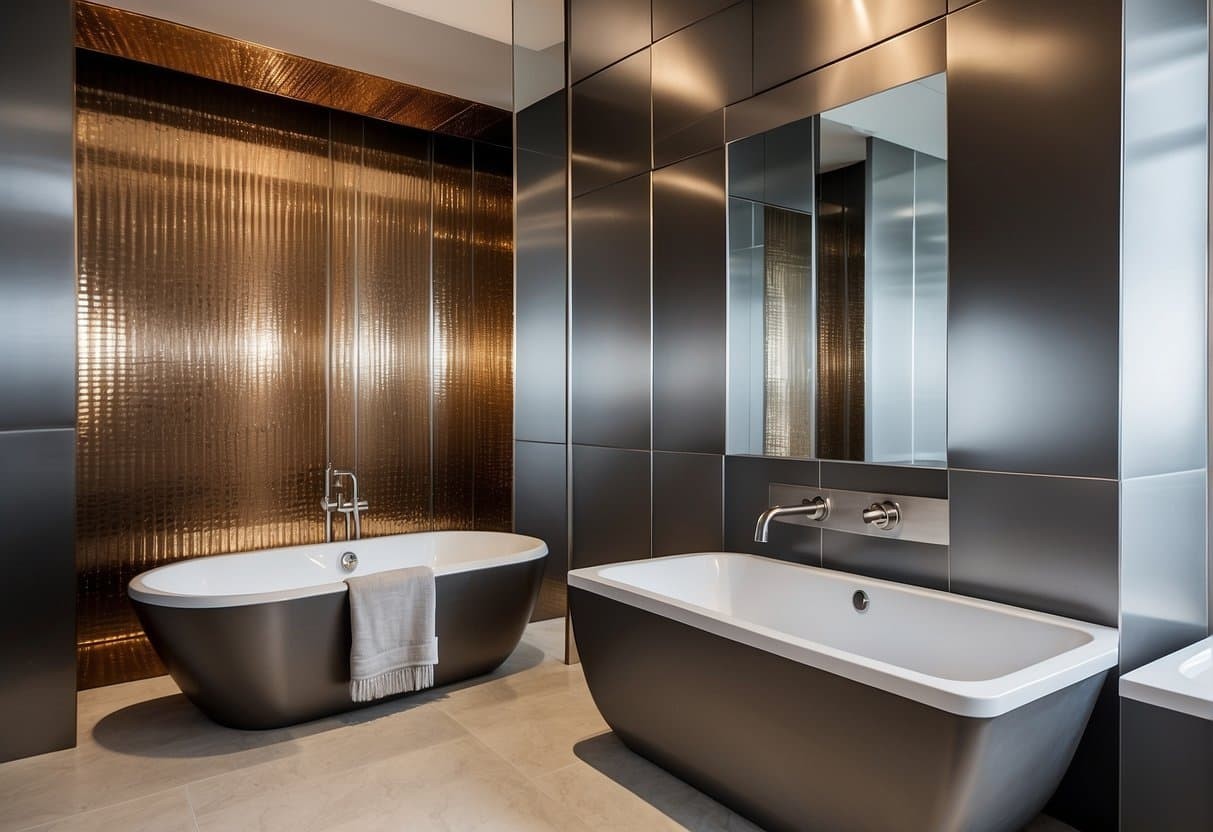
When it comes to unconventional bathroom wall coverings, metallic options stand out for their cutting-edge appeal, conjuring up images of opulence and sleek sophistication. Not only do these finishes boast impressive durability in humid environments, but they also offer incredible versatility, effortlessly adapting to a wide range of design themes.
The result is a bathroom that exudes refinement and visual interest, making it an ideal choice for those seeking to add a touch of glamour to their space.
Stainless Steel Panels
A stylish and functional choice for bathroom walls, stainless steel panels boast exceptional durability and resistance to moisture and corrosion. By installing these panels, homeowners can achieve a sleek, industrial aesthetic that is perfectly suited to modern or minimalist bathroom designs.
Brushed and Polished Metal Surfaces
Metal surfaces with brushed and polished finishes can significantly elevate the aesthetic appeal of bathrooms. The soft, textured appearance of brushed metal subtly masks fingerprints and watermarks, creating a sophisticated look that exudes understated elegance. In contrast, the high-gloss finish of polished metal produces a radiant reflection that amplifies the sense of space within the bathroom.
Both options embody luxury and can be effortlessly integrated into modern design schemes to create a truly exceptional atmosphere.
Glass Installations

When it comes to bathroom wall design, glass installations are an excellent choice for those seeking a contemporary and sophisticated look. Unlike traditional tiling, glass provides endless possibilities for customization, allowing homeowners to create unique spaces that reflect their personal style.
With options ranging from crystal-clear glass that exudes classic sophistication to frosted designs that ensure privacy, textured patterns that add visual interest, and countless others in between, the aesthetic versatility of glass installations is undeniable.
Frosted Glass Panels
Elegant solutions for achieving both privacy and style can be found in the form of frosted glass panels. The etched surface creates a soft glow by scattering light, effortlessly adding sophistication to a bathroom’s ambiance. This versatile solution is available in an array of patterns, permitting customization to align with diverse design preferences.
Clear and Textured Glass Options
By incorporating clear glass options into bathroom design, homeowners can effortlessly create a sense of openness and airiness, cleverly manipulating the perception of space. However, for those seeking added visual intrigue, textured glass varieties offer a unique twist. As light interacts with these dynamic surfaces, it refracts in distinct ways throughout the day, injecting an element of patterned complexity that harmoniously balances with the clarity of the clear glass components.
Ceramic and Brick Alternatives
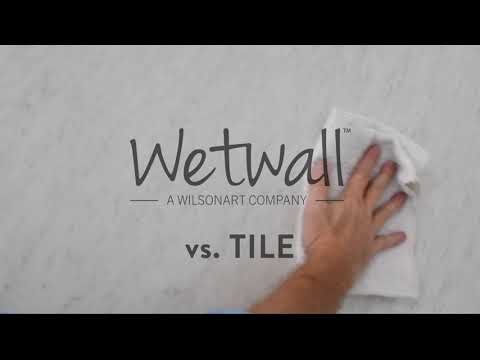
Homeowners seeking to replace traditional bathroom walls with more modern options often prioritize materials that combine the charm of classic ceramic or brick with the practicality they desire. Among the popular alternatives, ceramic laminate panels and faux brick veneers have gained attention for their unique blend of aesthetic appeal and functional benefits.
Ceramic Laminate Panels
Ceramic laminate panels seamlessly blend the timeless allure of genuine ceramic tiles with the practicality of a streamlined installation process. By featuring high-definition images of actual ceramic tiles, these panels deliver an uncanny resemblance to their traditional counterparts on bathroom walls.
Notably, they boast exceptional cleaning and maintenance properties, effortlessly repelling moisture and mold without the need for labor-intensive grouting.
This ingenious solution masterfully harmonizes the classic charm of tiles with the modern conveniences we’ve come to expect.
Faux Brick Veneers
For those who appreciate the charm of exposed brick, faux brick veneers offer a versatile and lightweight alternative that captures its rustic essence. These veneers are designed to replicate the texture and color variation of real brick, bringing an industrial-chic ambiance to bathroom spaces.
Made from high-density polyurethane or similar materials, they provide durability in humid conditions, allowing homeowners to enjoy the unique style of brick without the added complexity and bulk of actual bricklaying.
Special Considerations
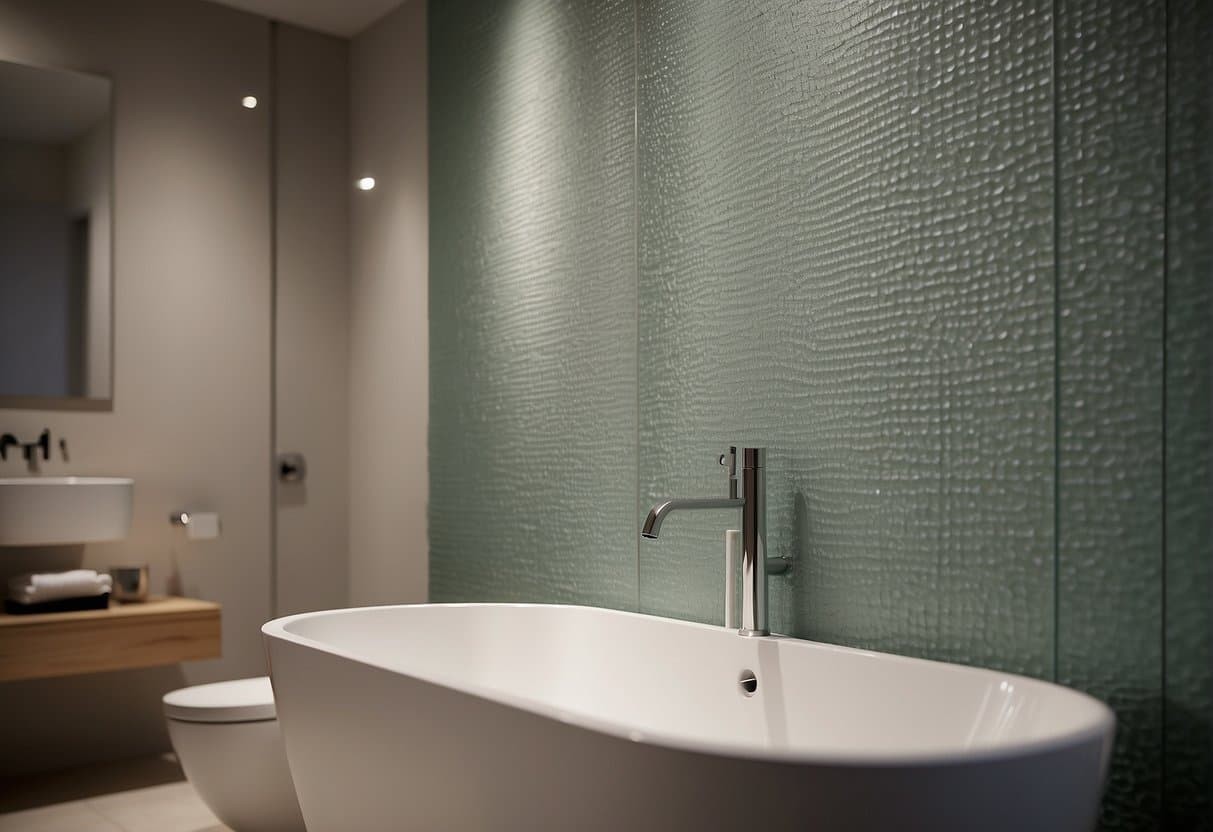
When selecting materials for bathroom walls, it’s crucial to weigh factors such as mold resistance, installation ease, and long-term maintenance and durability. By prioritizing these considerations, you can ensure the chosen wall coverings meet their intended purpose, providing cost-effective and enduring solutions for humid bathroom environments.
Mold and Mildew Resistance
In designing materials for bathroom walls, it is essential that they are capable of resisting mold and mildew growth, a phenomenon commonly fueled by high humidity and water exposure. To achieve this, options such as acrylic panels and PVC wall panels stand out for their excellent water resistance properties, significantly reducing the likelihood of mold development.
Ease of Installation
When it comes to installation ease, DIY enthusiasts and homeowners alike can’t help but consider the simplicity of materials like PVC or laminate wall panels. These options not only boast impressive weight reductions, but also arrive at a level of straightforwardness that’s hard to beat. By opting for these materials over traditional tiles, users can bank on significant time savings and reduced expenses – a winning combination for any project.
Maintenance and Durability
When it comes to bathroom surfaces, durability and maintenance are inextricably linked. The constant exposure to water can cause wear and tear over time, making regular upkeep essential. Fortunately, alternatives like natural stone and PVC panels offer a durable and low-maintenance solution. These materials provide a long-lasting finish that resists the effects of water and humidity, reducing the need for frequent cleaning and maintenance.
Design and Aesthetic Factors
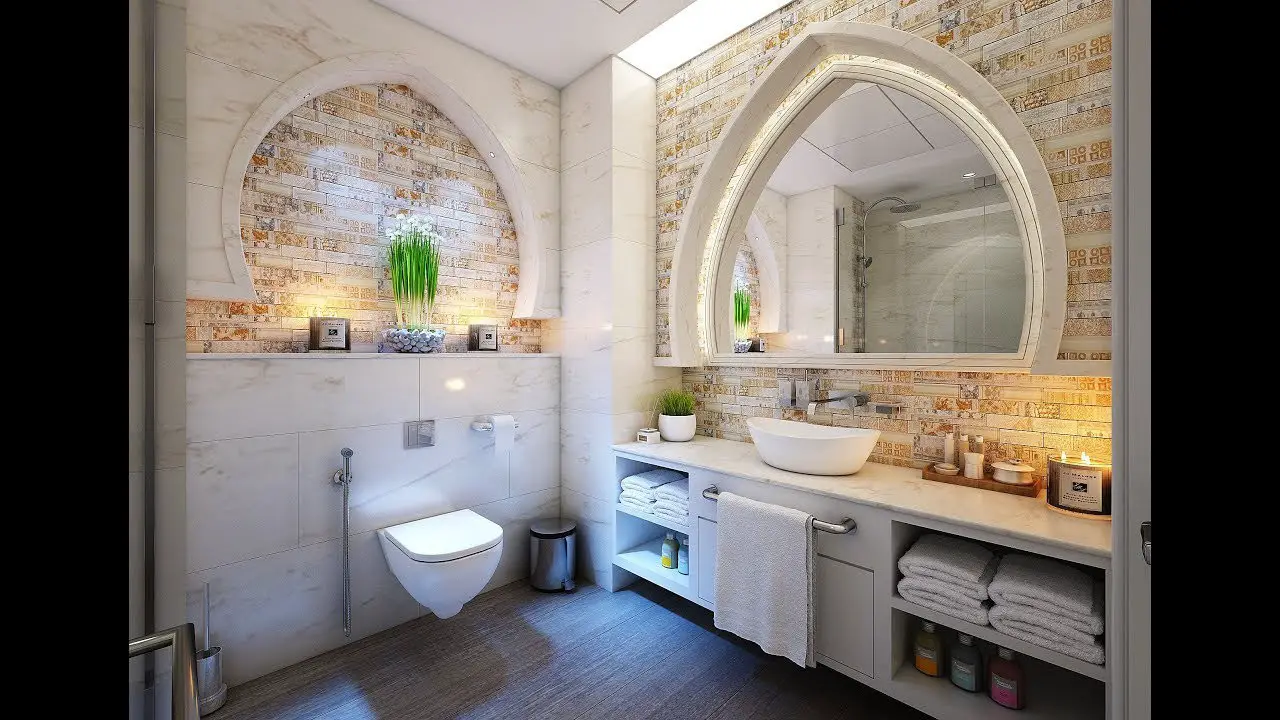
To reimagine your bathroom without tile, it’s essential to thoughtfully evaluate the design components that will define the space. The visual aspects of this transformation are just as crucial as its functional implications, as they collectively contribute to the creation of a personalized oasis. Here, textures, patterns, and color schemes serve as the foundation upon which the desired atmosphere is built, elevating the bathroom from mere functionality to a true retreat.
Textures and Patterns
By incorporating patterns on bathroom walls, you can infuse your space with visual interest and dynamism. From geometric designs to subtle motifs, there’s a wide range of options available. One alternative to traditional tiles is wall panels, which can mimic the look of natural stone or wood, offering a unique texture that creates an organic and comforting atmosphere.
Additionally, products like PVC or laminate wall panels not only introduce new textures but also create a sense of depth and visual movement within the space.
Color Schemes and Aesthetics
The colors chosen for a bathroom have a profound impact on its visual appeal. Lighter shades can create the illusion of a larger space, exuding an airy feel, whereas darker tones can infuse a sense of sophistication and drama. Furthermore, varying color schemes can harmoniously complement natural materials like stone, elevating the overall beauty and ambiance.
When applied thoughtfully, expressive color combinations can dramatically shift the mood of a bathroom, reflecting one’s unique personal style and creating a space that is truly reflective of their individuality.
Additional Bathroom Elements
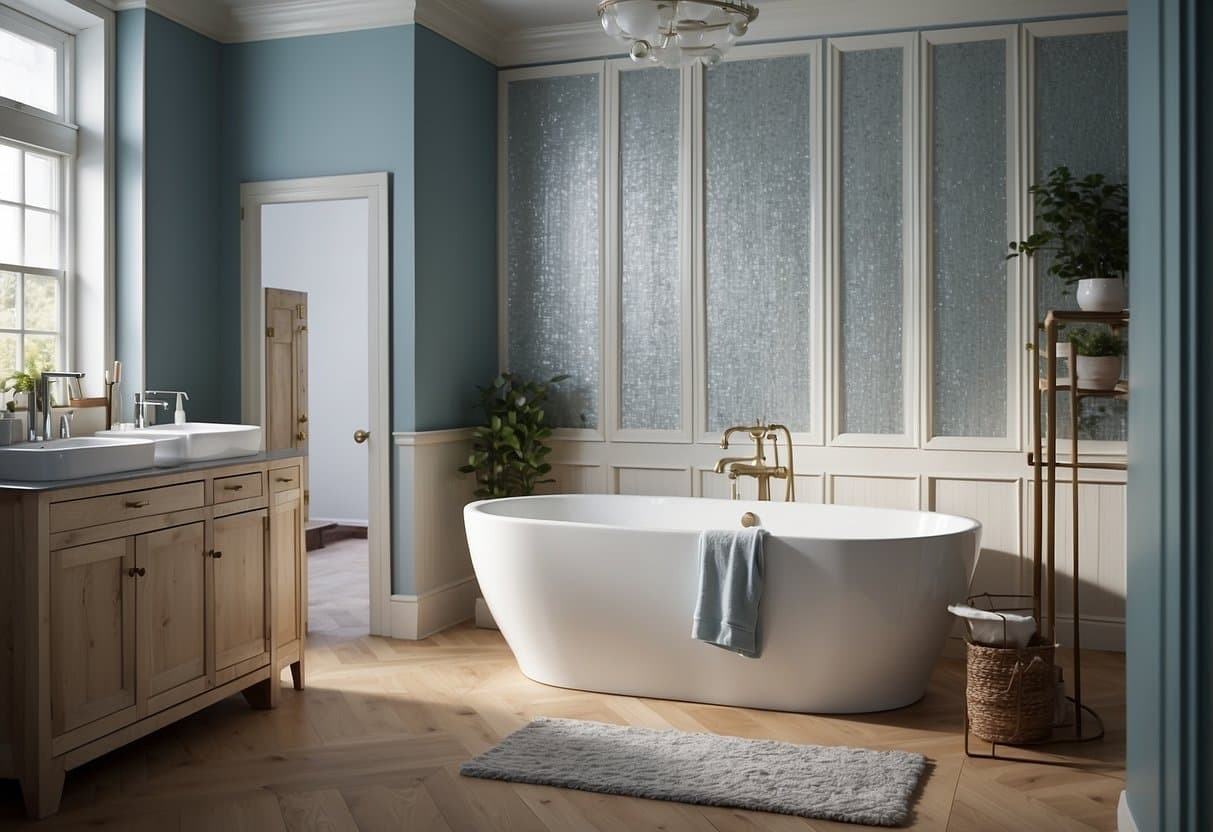
For a successful bathroom renovation that moves beyond traditional tiles, it’s crucial to prioritize key areas like shower walls and enclosures, as well as sinks and countertop spaces. By doing so, you’ll not only improve the room’s overall functionality but also elevate its visual appeal.
Shower Walls and Enclosures
When it comes to selecting materials for shower walls and enclosures, homeowners often opt for acrylic and PVC-backed composite options. These choices offer a smooth, waterproof surface that is effortless to clean and maintain. Additionally, high-pressure laminate and high-grade fiber are gaining popularity due to their impressive durability and sophisticated finish.
For those seeking a truly show-stopping feature in their bathroom, marble slabs can be an attractive alternative to traditional tiles. With their distinctive patterns, marble adds a touch of luxury to the shower area, making it a standout design element.
Bathroom Sinks and Counter Areas
In the vicinity of sink and counter areas, functionality and water-resistance take center stage. Durable options like quartz and granite solid surface materials excel at resisting stains and requiring minimal upkeep. For a unique touch, laminated panels can mimic the appearance of wood, stone, or other textures, offering a bespoke aesthetic that’s both cost-effective and customizable to fit any design scheme.
Eco-Friendly and Sustainable Practices
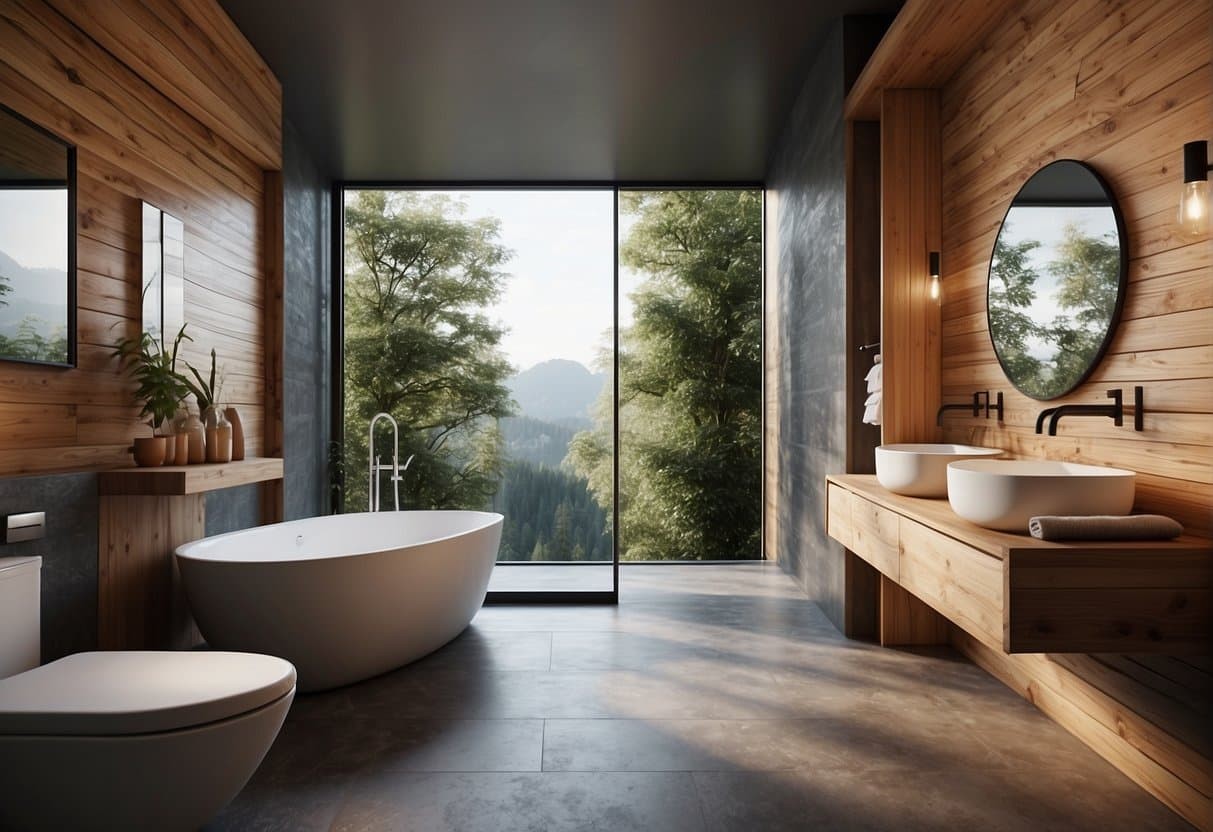
As you contemplate bathroom renovations, it’s crucial to integrate eco-friendly and sustainable principles into your design. Not only do these approaches have a profound impact on the environment, but they can also bring a distinctive charm to the bathroom space, setting it apart from more conventional designs.
Sustainable Materials and Practices
When it comes to designing a bathroom with sustainability in mind, one of the most crucial considerations is the incorporation of environmentally friendly materials. These materials should not only be renewable but also recyclable and have a minimal impact on the environment. One key aspect of sustainable bathroom design is water conservation. This can be achieved through the installation of low-flow toilets and aerated faucets, which can significantly reduce water consumption.
In addition to water conservation, another important practice is the selection of sustainable construction materials. Hempcrete, for instance, is a natural and durable material that provides excellent insulation and moisture regulation. It can be used as a wall infill, reducing the reliance on less sustainable options. Furthermore, when it comes to choosing materials, look for those certified by environmental standards like FSC for wood or bamboo.
This ensures that the materials you’re using have been sourced in an environmentally responsible manner. Additionally, prioritize materials that can be recycled to minimize their contribution to landfill waste.
Eco-Friendly Wall Coverings
Eco-friendly wall coverings provide a sustainable alternative to traditional tiling, offering both aesthetic appeal and environmentally conscious benefits. Several innovative materials stand out for their commitment to sustainability.
Among these eco-friendly options are recycled glass tiles, which convert waste into long-lasting, visually appealing bathroom walls that mimic the look of conventional tiles.
Natural lime plaster is another option, boasting breathability that prevents mold growth in high-moisture environments like bathrooms. Cork also deserves recognition for its rapid re-growth rate and water-resistance, adding warmth and texture to bathroom walls.
By incorporating these eco-friendly materials into bathroom design, homeowners can significantly boost the sustainability quotient of their interiors.
These options not only reduce environmental impact but also offer long-term durability and improved indoor air quality.
Regional Considerations
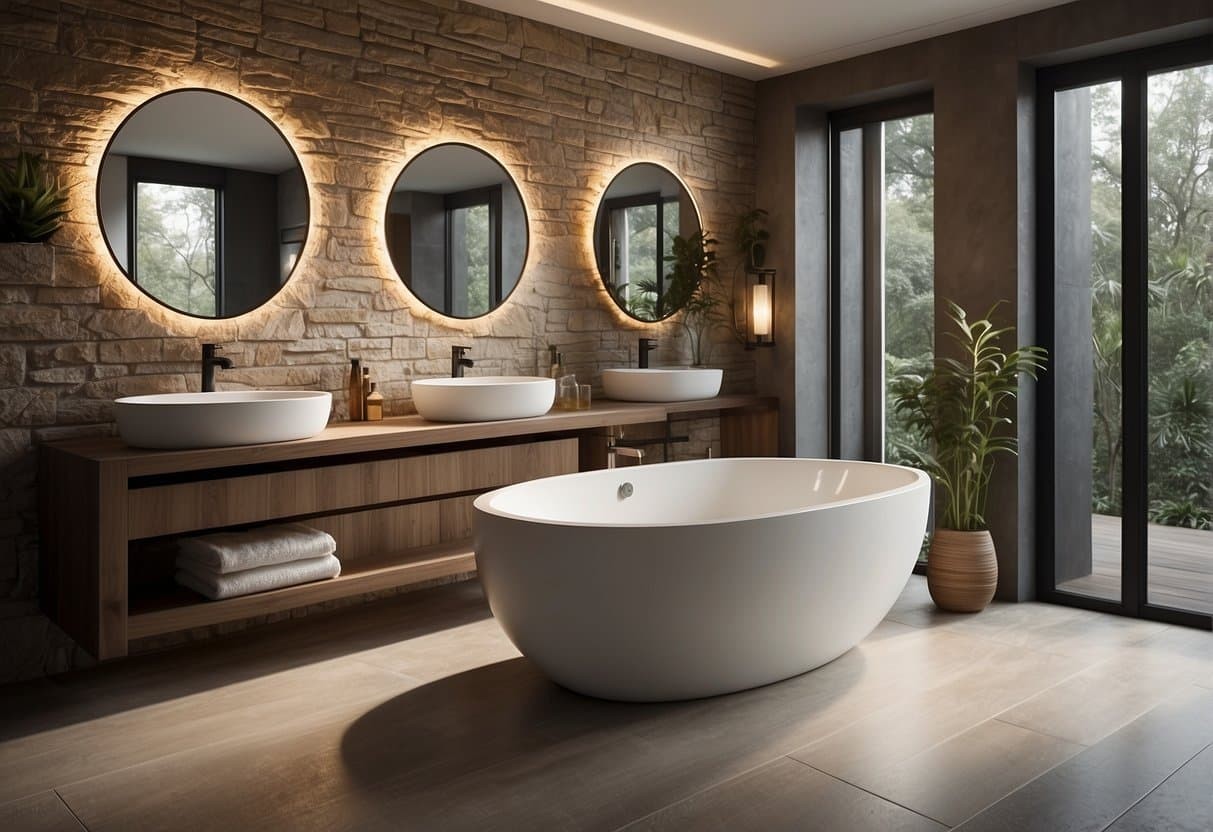
While exploring alternatives to traditional tiles for bathroom wall coverings, it’s crucial to factor in local climate conditions, particularly humidity levels. Additionally, designers should consider the unique characteristics of UK bathrooms, such as limited spaces, typically seen in cloakroom areas, and adapt their choices accordingly.
Materials Suited for High Humidity
In humid regions, steam buildup can be a persistent problem, demanding materials that can withstand prolonged exposure to moisture without compromising their integrity. In such environments, it’s essential to select products that not only resist water but also ensure easy installation and affordability. The Bathroom Blueprint’s PVC or laminate wall panels are ideal for these areas due to their practicality, budget-friendliness, and ability to withstand constant moisture.
Alternatively, acrylic panels from Designing Idea offer a waterproof solution that can replicate the appearance of traditional bathroom tiles without the maintenance headaches.
Adaptations for UK Bathrooms and Cloakrooms
In the UK, where bathrooms and cloakrooms may be smaller, it’s crucial to consider space-efficient solutions. One such option is PVC panels, which not only offer moisture resistance but also add a touch of visual appeal without consuming valuable space. These lightweight panels can be used as decorative wall cladding in tight spaces, making them an ideal choice for compact UK bathrooms and cloakrooms.
According to Hounz, these panels are a suitable alternative that can enhance the visual spaciousness of small areas, while Homenish provides ideas that can be easily adapted for compact UK cloakrooms.
Advanced Material Innovations
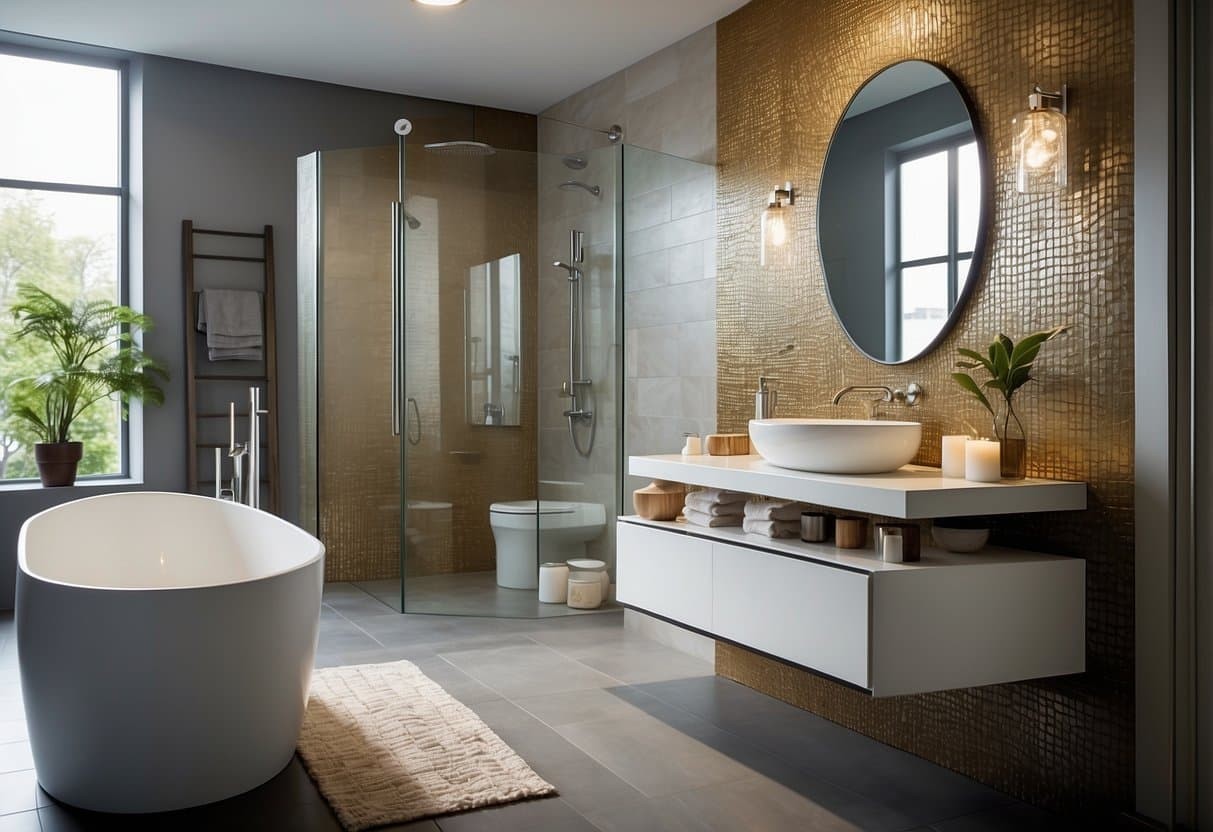
The advent of innovative materials has revolutionized the world of bathroom wall design, paving the way for the widespread adoption of cutting-edge alternatives to traditional tiles. Not only do these modern solutions boast a significant visual upgrade, but they also bring tangible benefits in terms of durability and upkeep, making them an attractive option for homeowners seeking a stylish yet practical bathroom renovation.
Fiberglass Wall Treatments
For those seeking a modern alternative to tiles, fiberglass wall treatments have emerged as a savvy choice. One of the key advantages of these panels is their seamless design, which creates a sleek and streamlined look by eliminating grout lines altogether. This aesthetic appeal is further enhanced by the fact that fiberglass panels are crafted in large sizes, allowing for a cohesive and uninterrupted visual effect.
In addition to their visually pleasing nature, fiberglass wall treatments also boast impressive durability. Their high resistance to moisture makes them an excellent choice for bathroom environments where humidity is a concern. Furthermore, the lightweight nature of these panels simplifies the installation process, as they are easier to handle and maneuver compared to traditional materials.
Solid Stone Slabs
Solid stone slabs embody the epitome of luxury and durability in bathroom wall surfacing. Crafted from materials such as granite, marble, or slate, each slab’s intricate pattern brings an undeniable touch of natural elegance into the space. Beyond their visual allure, these slabs boast remarkable sturdiness, capable of withstanding the high moisture levels characteristic of bathrooms.
While they may be more expensive and require professional installation due to their weight, the long-term value they bring to a property, coupled with their durability, often justifies the initial investment.
Cost and Budgeting
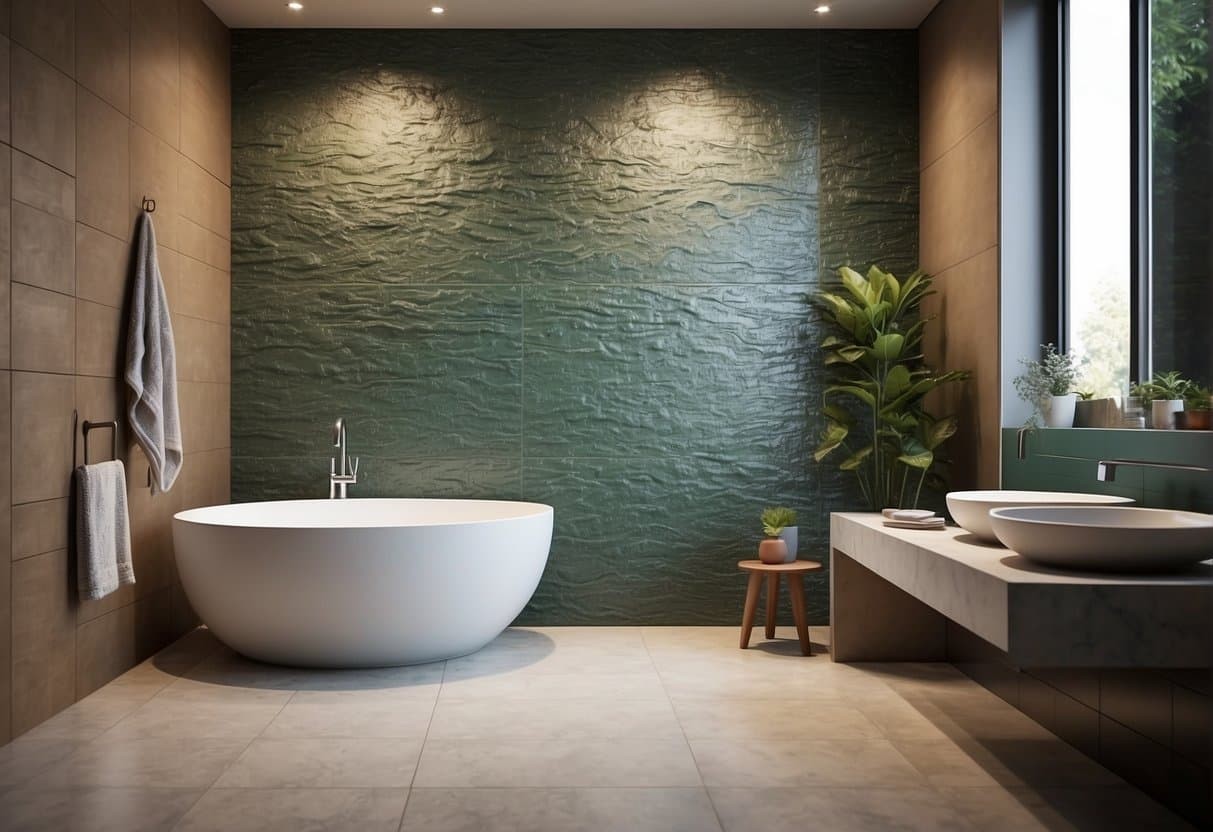
While opting for alternative solutions to traditional bathroom tiles can result in significant cost savings, homeowners must weigh these budget-friendly choices against the complexity of calculating renovation costs to make informed decisions. By considering both the expense-effective options and the intricacies involved in wall renovation estimates, homeowners can ensure a more efficient financial planning process.
Budget-Friendly Alternatives
When it comes to budget-friendly bathroom renovations, the right materials can make all the difference. One cost-effective solution is PVC wall panels, which not only offer an affordable upfront price but also simplify the installation process, reducing labor costs in the long run. Another creative and economical option is paint specifically designed for humid environments, allowing homeowners to give their bathroom walls a fresh new look without breaking the bank.
Calculating Costs for Wall Renovations
When planning bathroom wall renovations, it’s essential to factor in both material costs and labor fees to get an accurate estimate. To do this, consider the following factors:Firstly, calculate the raw material expenditure by checking the per-unit cost based on the bathroom’s measurements. This will give you a clear idea of what you’ll be spending. Secondly, if professional installation is required, obtain quotes from multiple contractors to determine labor fees.
Finally, to account for any unexpected expenses that may arise during the renovation process, consider adding a 10-15% buffer to your calculated estimate.
Professional Perspectives
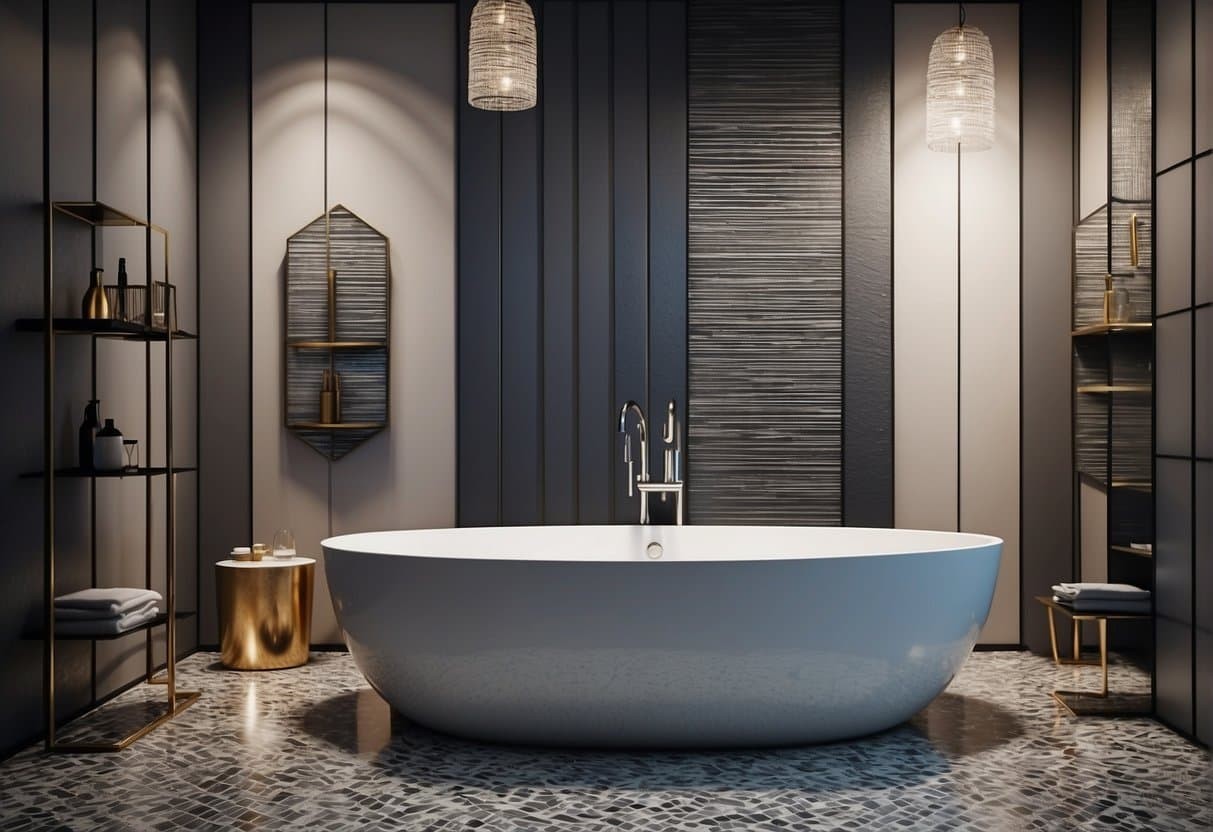
When evaluating alternatives to conventional bathroom tiles, industry experts share valuable insights on both installation and design strategies. By pooling their expertise as professional installers and interior designers, homeowners can create functional and stylish spaces that exceed expectations.
Expert Installation Recommendations
When it comes to finishing bathroom walls, professionals stress that proper installation is crucial for success. One popular option is using wall panels, which offer a relatively easy and low-maintenance solution compared to traditional tiling methods that require grouting. However, it’s essential to ensure the surface is perfectly level to prevent warping or uneven seams.
According to Homenish, materials like PVC or laminate can provide a seamless look and are often water-resistant, making them suitable for humid bathroom environments. Another efficient alternative is acrylic panels, which come in a diverse range of colors and patterns, offering waterproof characteristics without the need for grouting. This results in a smooth surface that’s easy to clean.
Installation typically involves attaching the panels directly to wall studs or over existing surfaces, reducing the complexity of installation.
Tips from Interior Designers
When selecting wall coverings for the bathroom, it’s essential to consider the overall aesthetic of the space. Interior designers often recommend natural stone for its timeless quality and unique variations in patterns and hues. As showcased by Roomdsign, stone can instantly elevate the space, giving it a luxurious, spa-like feel. In addition to stone, subtle colors play a crucial role in creating a serene bathroom environment.
Designers suggest choosing colors that harmonize with the lighting and size of the bathroom. Lighter shades can effectively make small bathrooms appear larger and more airy, while darker tones can add depth and warmth to larger spaces. What’s noteworthy is that using alternative materials doesn’t mean sacrificing color variation; many options come in a wide palette, allowing for seamless integration into various interior design themes.
Frequently Asked Questions
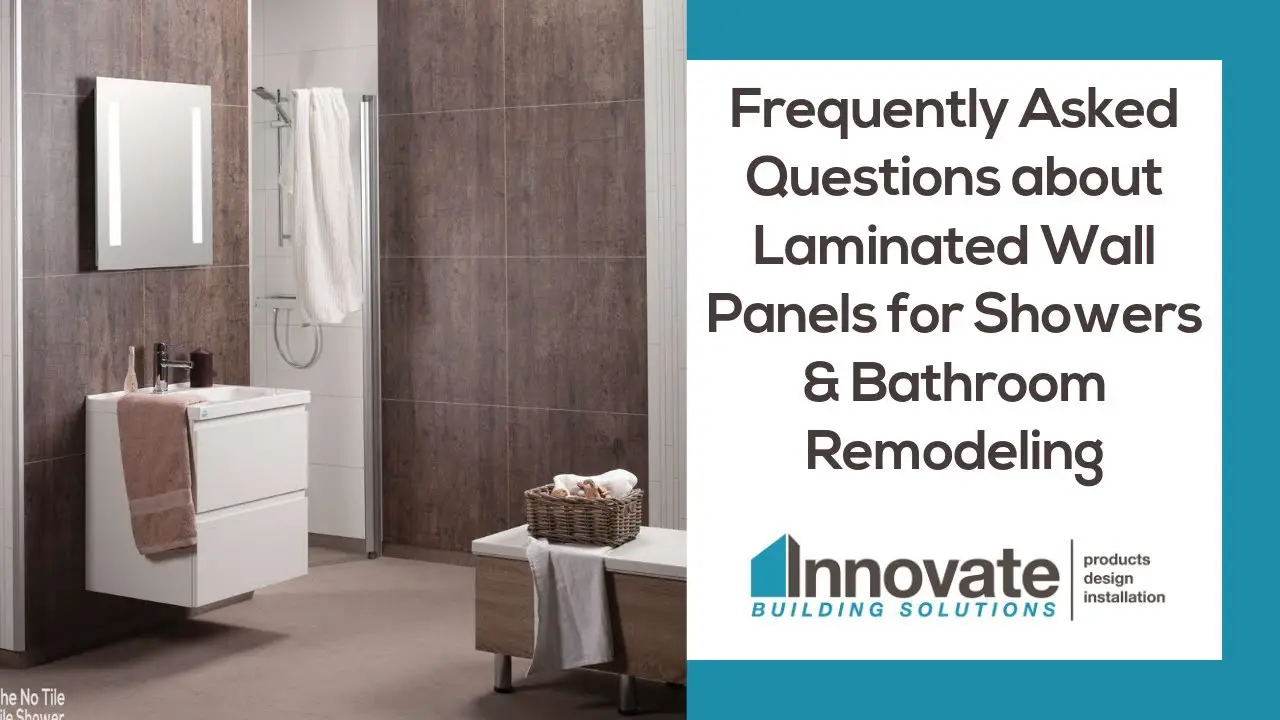
When it comes to exploring alternative solutions to traditional bathroom tiling, one of the most pressing concerns for homeowners is the balance between cost-effectiveness, water resistance, and aesthetic appeal. To provide clarity on this topic, we’ve compiled a list of frequently asked questions that tackle common inquiries with straightforward, informative answers.
What are cost-effective substitutes for traditional tiling in bathrooms?
When it comes to finding cost-effective alternatives to tiles, there are a few options worth considering. One such option is PVC wall panels, which not only offer an affordable solution but also simplify the installation process. Another budget-friendly alternative is acrylic sheets, which can mimic the look of tiles without the hassle and complexity of tile installation.
How can I ensure my bathroom walls are water-resistant without using tiles?
To guarantee a water-resistant design, consider incorporating materials that naturally repel moisture, such as acrylic panels or waterproof laminate wall panels. These options are specifically engineered to withstand the humidity commonly found in bathroom environments, ensuring a long-lasting and worry-free installation.
What are the alternative waterproof materials for bathroom walls?
While traditional tile options may not be the best fit for high-moisture areas, there are several alternatives that can provide waterproof properties. For instance, acrylic panels and laminate wall panels specifically designed for wet zones offer a durable and water-resistant solution. Additionally, natural stone is a premium option that provides exceptional durability and resistance to water when properly sealed.
Although more expensive than other options, natural stone’s unique characteristics make it an attractive choice for those seeking a long-lasting and low-maintenance solution.
Can PVC panels be used as a tile replacement in bathrooms?
For those looking to revamp their bathrooms without breaking the bank, PVC panels present a compelling alternative to traditional tiles. Not only are they simple to install, but they also boast a range of designs that convincingly mimic the look and feel of tile, all while offering the added benefit of moisture resistance – a crucial consideration for any bathroom renovation.
What materials can I use for a durable and stylish bathroom wall finish?
To achieve a lasting and sophisticated aesthetic, homeowners can opt for the timeless beauty of natural stone, imbuing their space with refinement and resilience. Alternatively, they may choose to utilize waterproof paint applied directly onto sturdy backing materials, resulting in a sleek and contemporary appearance that seamlessly blends with its surroundings.
Are there innovative wall coverings suitable for bathroom environments aside from tiling?
Bathroom walls can now be transformed with innovative and versatile options that cater to the demands of this humid environment. Acrylic panels, for instance, provide an unparalleled level of customization, allowing homeowners to choose from a vast array of colors and patterns that perfectly suit their unique style.
Moreover, waterproof wall wallpapers specifically designed for bathrooms offer an added layer of protection against moisture while still providing a stylish and customizable aesthetic.


